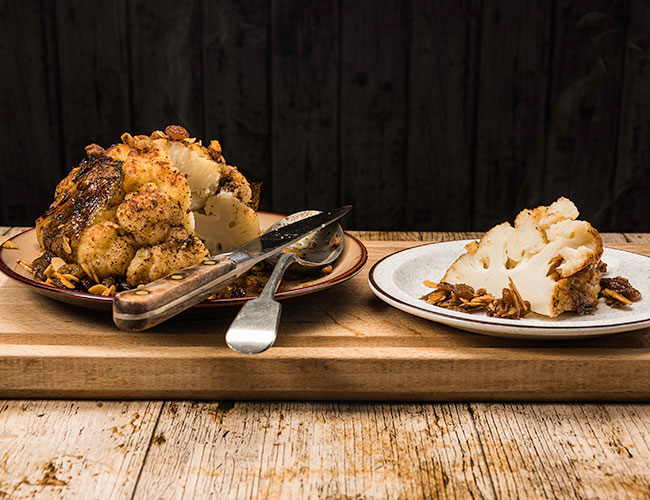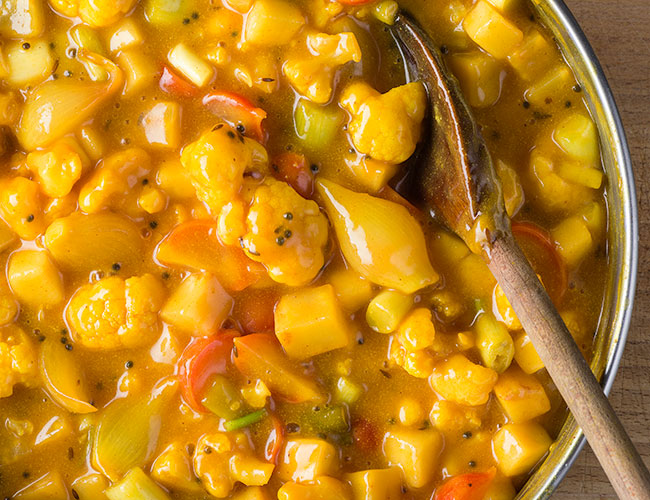Home-grown harvest: cauliflower
This very British brassica has emerged from its blanket of cheese sauce to become the darling of Instagram, says chef-consultant Russell Brown
The popularity of the humble cauliflower has increased in recent years, mostly in its raw and roasted forms. Cauliflower purée with seared scallops has become something of a classic, but roasting cauliflowers whole, cooking thick slices sous vide and roasting them over charcoal are also regularly seen, as well as cauliflower couscous or rice.
Instagram lists upwards of 70,000 posts tagged #cauliflowerrice and cauliflower is also used to make a faux pizza base, where blitzed or grated cauliflower is mixed with egg, cheese and sometimes ground almonds before baking and then topping.
We are blessed with an almost continuous supply of cauliflower in the UK. The vegetable is part of the brassica family and, although white is the most common colour of the curds, there are also green, orange and purple varieties. However, the colour is lost when it is boiled or steamed as the anthocyanins responsible for the colour are water soluble.
Cauliflowers are considered to be one of the more difficult brassicas to grow. Warm weather can cause significantly accelerated growth, with the heads increasing by up to 3cm a day. This can cause a loud squeaking noise as the florets rub together, known as ‘cauliflower creak'. In 2015, warm nights following the coldest June for 24 years made this phenomenon particularly pronounced.
Cooking methods for cauliflower are diverse, but a key point is to keep the cooking time as short as possible to avoid the sulphurous smell that can be associated with all brassicas. Boiling, steaming, roasting and sautéing are all used alongside more modern techniques, such as sous vide. Cauliflower cheese is evidently still one of the most common dishes, even if it is a dish with many variations. Indian spices are popular along with flavours from the Middle East and the Mediterranean, such as cumin, chilli, saffron, almonds, raisins, apple, mustard and anchovies.
Paul Ainsworth at No 6 in Padstow cooks thick slices of cauliflower sous vide with beurre noisette, then roasts the slice before serving with smoked eel, Bramley apple purée and raw apple. This is a dish I tried last year and it is a clever blend of flavours and textures, with the rich eel balanced by the acidity of the Bramleys and complemented by the nutty flavour of the cauliflower.
Putting a twist on the Indian spicing, Graham Garrett, chef-proprietor at the West House in Biddenden, Kent, serves tandoori cauliflower, monkfish cheek and mussel masala; and at Lumière restaurant in Cheltenham, Gloucestershire, Jon Howe serves a dish incorporating roasted cauliflower, Romanesco, parsnip and Cavolo Nero with truffle and beer vinegar. Sven-Hanson Britt, executive chef at Miele GB, goes down the popular route and recommends cheese, cheese and cheese!
Market report
There are three cauliflower crops or seasons each year, so there should be an almost continuous supply of home-grown varieties. Sadly, cauliflowers can really struggle with adverse weather, much more so than most other brassicas. Too cold and they won't grow; too warm and they glut; too wet and they die.
If there is a good supply, expect to pay about £1.20 to £1.50 for a decent-sized head. In times of cauliflower crisis, prices can be as high as £3 each.
Charlie Hicks
Buying and storage tips
- The curds should be firm, tight and free from blemishes
- The green leaves should be crisp
- Keep refrigerated with the curds down to prevent condensation
- Store the cauliflower unwashed and do not wrap tightly
Winter piccalilli
For the vegetables
- 1 small cauliflower, cut into florets
- 100g baby onions, peeled
- 150g celeriac, cut into 1cm cubes
- 1 bunch winter radishes, halved or quartered
- 1 bunch spring onions, cut into 2cm lengths
- 1 Bramley apple, peeled, cored and diced
- 2 litres water
- 100g salt
Prepare all the vegetables and fruit, reserving the spring onion and the apples. Make a brine with the salt and water and use it to cover the remaining vegetables. Brine the vegetables overnight, then drain and wash thoroughly.
For the sauce
- 1tbs olive oil
- 2tsp yellow mustard seeds
- 1tsp cumin seeds
- ¼ tsp cayenne pepper
- 1tsp turmeric
- 500ml cider vinegar
- 75g runny honey
- 50g caster sugar
- 25g cornflour and 15g English mustard powder mixed to a smooth paste with 200ml cold water
Mix a ladleful of the hot vinegar with the cornflour mix and then gradually stir this back into the pan. Allow to thicken. Remove from the heat and adjust the seasoning. Stir in the spring onion pieces and the diced apple, then transfer to sterile jars.
Piccalilli is an excellent accompaniment to cold meats, cheeses and pies.
Whole roasted spiced cauliflower with almonds and sultanas
- 1 whole cauliflower
- 50ml olive oil
- 1tsp yellow mustard seeds
- 1tsp ground cumin
- 1 pinch chilli flakes
- 60g unsalted butter
- Maldon sea salt and fresh black pepper
- 30g flaked almonds
- 50g sultanas covered with boiling water
- 1 lemon

ove the leaves from the cauliflower and cut out the core. Wash the cauliflower under running water and then steam or blanch in simmering water for around six minutes. Drain and then dry.
Heat the oil in a deep sauté pan and toast the mustard seeds, and then add the cumin and chilli flakes. Add the butter and, when it starts to foam, place the cauliflower in the pan, season and baste with the butter. Transfer to the oven at 200ºC and cook, basting frequently, for approximately 15 minutes.
Remove the cauliflower and add the almonds to the pan. When the almonds have toasted, add a good squeeze of lemon juice. Grate some lemon zest into the pan, drain the sultanas and add them to the mix. Check the seasoning and adjust as required. Pour over the cauliflower to serve.








